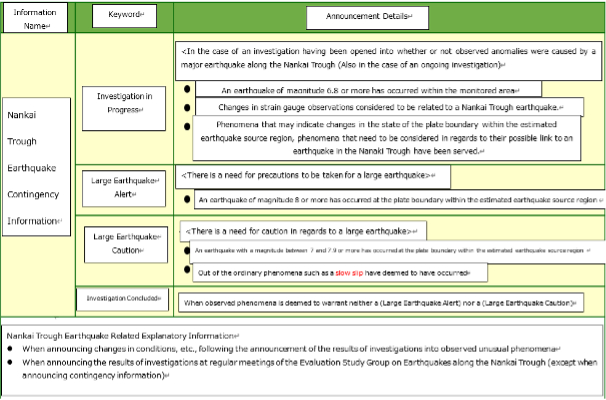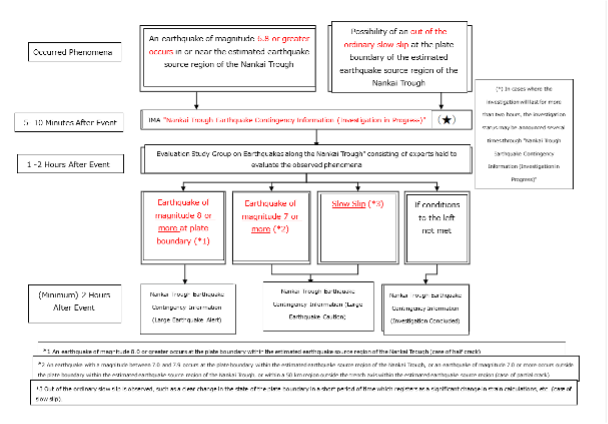3.12.2022

Do you remember the magnitude 6.6 earthquake that struck under the Hyuganada Sea late at night on January 22 this year? If this earthquake had been of a slightly larger magnitude, 6.8 or more, the JMA would have issued "Nankai Trough Earthquake Contingency Information (Investigation in Progress)”.
Contingency information tends to be conflated with information on the Tokai earthquake (predictive information/cautionary information, observation/contingency/routine survey data) that was released from 2004 to 2017 and is often thought of as information predicting “a coming Nankai Trough Earthquake" but, in reality, this is not the case.
Contingency information is released when abnormal phenomena such as "half cracks," "partial cracks," or "slow slips" are observed in the earthquake source region of the Nankai Trough, and these phenomena are likely to be related to a large-scale earthquake along the Nankai Trough. In other words, it is an alert based on specific abnormal phenomena to prepare for the occurrence of a large earthquake that may occur as a result of said phenomenon.
Nankai Trough Earthquake Contingency Information is issued by the JMA (Japanese Meteorological Association) when the possibility of a large-scale earthquake having occurred along the Nankai Trough is assessed to have increased relative to normal conditions.
The "Guidelines to Consider Prevention Responses for Various Types of Nankai Trough Earthquakes (1st Edition)" were formulated in March 2019 and became operational on May 31, 2019.
The information released in these guidelines included "Nankai Trough Earthquake Contingency Information" and "Nankai Trough Earthquake Related Explanatory Information," with the keywords (Investigation in Progress), (Large Earthquake Alert), (Large Earthquake Caution) attached to the different types of contingency information.

Nankai Trough Earthquake Contingency Information is set up to be announced in as little as two hours, in the following sequence.

So, what actions should you actually take when such information is announced? Checking the "Guidelines to Consider Disaster Prevention Measures in Preparation for Various Types of Nankai Trough Earthquakes (1st Edition)" should be your first course of action. It describes basic concepts and tips for residents, local governments, and companies. The guideline will be discussed in the next article.
Thumbnail image source: PhotoAC
Reference material in the main text "Guidelines to Consider Disaster Prevention Measures in Preparation for Various Types of Nankai Trough Earthquakes (1st Edition)".
http://www.bousai.go.jp/jishin/nankai/pdf/honbun_guideline2.pdf

